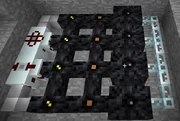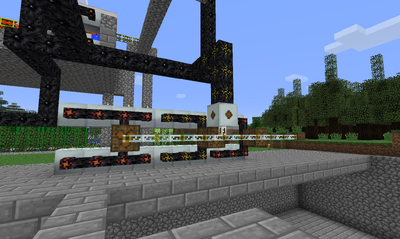|

Cables
General[]
Industrial Craft Cables are used to distribute EU from EU producing machines such as Generators, to EU consuming machines such as Macerators. Several types of cables may be crafted, each with their own characteristics as to how much "Voltage" (EU Packet Size) they're able to handle.
Types of Cables[]
The crafting recipes for each type of cable are listed below. They are arranged in the amount of "Voltage" (EU Packet Size) they're able to carry without "vaporizing".
Usage[]
While cables are virtually the only way EU may be transmitted from EU generators to EU consumers, there are many different configurations as to how to utilize cables in the transmission of EU.
Direct Connections[]
When the player wishes to power a Macerator or other EU consuming block, cables must be laid to an EU generating machine such as a Generator via right clicking on the path the player wishes to use to route power. Each cable "block" will automatically connect to another adjacent cable. Once a proper and complete path between the two machines has been created, EU will be transmitted across the cabling.
Machine Interactions[]
If an EU generating machine is in contact with an EU consuming block, EU will automatically be transmitted from the EU generator to the EU consumer without any cables. However, EU cannot be transmitted through these consumer blocks, with the exception of EU Storage blocks such as the BatBox or MFE, or a transformer. By routing cable from, using the example above, a Generator to a BatBox, and then from the BatBox to the Macerator, EU will be transmitted from the Generator to the BatBox, and then is stored until the BatBox is able to transmit a complete "Packet" of Voltage to the Macerator.
Connections Over Long Distances[]
All cables suffer from distance-related energy losses - each cable destroys a tiny portion of EU that is transmitted over it. There are several ways to offset this - Transformers, Insulation, and EU Storage. For higher-tier cables, the insulation also reduces the amount of shock damage the player and mobs (such as NPC's) receive within proximity of a live high voltage cable.
Insulation[]
Insulation reduces the amount of EU lost as it travels through a cable, it can be added simply by placing the cable in a crafting grid with some rubber. A cable already placed in the world may have insulation added or removed with a pair of Insulation Cutters.
Cable Management[]
Painting Cables[]
For more advanced EU transmission techniques, cables may be colored using a Painter. Note that the cables must have insulation to do this, therefore Tin Cables, which cannot be insulated, cannot be painted also.
Cables of different colors will not connect to one another. Cables that are uncolored however will connect to colored cables. Players not aware of this behavior may inadvertently destroy some of their EU infrastructure through exploding machines or cables vaporized by too high a voltage (EU Packet size).

Examples of colored cables. Note how uncolored cables connect to colored ones, but cables of different colors will not.
Cables and Game Performance[]
For players with large EU networks, good cable management may also prevent drops in frame rates within the game if the number of cable intersections the game must make calculations for is kept to a minimum.
It seems that the cables which you normally craft, are just block placers; the blocks have ID 228.
Special Cables[]
Industrial Craft includes two types of cables that interact with redstone:
The detector cable simply emits a redstone signal upon a live flow of EU through the cable.
Contrary to it's name, the splitter cable does not halve the EU to one connection side or the other. It is simply a redstone activated switch, cutting off any EU flow through itself upon receiving a redstone signal.
Cable Efficiency[]
All cables suffer distance-related energy losses, and depending on the tier and insulation of the given cable, the losses can vary greatly. The general unit for cable efficiency is EU/block. It shows how much EU every EU Packet loses per block. The number is accumulated along the whole length of the cable, and then rounded down to the nearest integer. Therefore, if a distance is short enough, the EU loss will remain zero. For example, since Insulated Copper Cable loses 1 EU every 5 blocks, a 4 block long Insulated Copper Cable won't lose any EU.
| Tin Cable | Copper Cable | Gold Cable | HV Cable | Glass Fibre Cable | Detector / Splitter Cable | |||||||
|---|---|---|---|---|---|---|---|---|---|---|---|---|
| EU/b | EU loss | EU/b | EU loss | EU/b | EU loss | EU/b | EU loss | EU/b | EU loss | EU/b | EU loss | |
| Uninsulated | 0.025 | 1 EU every 40 blocks | 0.3 | 1 EU every 3.33 blocks | 0.5 | 1 EU every 2 blocks | 1.0 | 1 EU every block | 0.025 | 1 EU every 40 blocks | 0.5 | 1 EU every 2 blocks |
| Insulated (1") | --- | 0.2 | 1 EU every 5 blocks | 0.45 | 1 EU every 2.22 blocks | 0.95 | 1 EU every 1.05 blocks | --- | --- | |||
| Insulated (2") | --- | --- | 0.4 | 1 EU every 2.5 blocks | 0.9 | 1 EU every 1.11 blocks | --- | --- | ||||
| Insulated (3") | --- | --- | --- | 0.8 | 1 EU every 1.25 blocks | --- | --- | |||||
Voltage Efficiency[]
Depending on the EU traveling through a cable it may be more efficient to use higher voltage cables and packets. This is because EU/b isn't applied on the total EU/t that travels the cable but on every single EU-Packet. So a copper cable carrying 320 EU/t over 10 Blocks of insulated copper cable is really carrying 10*32 EU-Packets and instead of: 320EU-2EU=318EU you get: (32EU-2)*10=300EU. But when using 512 EU-Packets and 2x insulated gold cables you get: 320EU-4EU=316EU. In this example this is a difference of 16 EU over 10 Blocks.
The formula for overall EU/b is: Combined EU/t divided by Desired packet size multiplied by Cable's EU/b per Packet equals Combined EU/b
Below is an example of different EU/t packed into different EU-Packets and carried with different cables, cables are full insulated, EU-P equals EU-Packet, results are in Overall / Combined EU/b (not EU/b per Packet), results can't be rounded down to nearest integer.:
| Example EU/t | Tin Cable | Copper Cable 1" | Gold Cable 2" | HV Cable 3" | Glass Fibre Cable | ||||||||||
|---|---|---|---|---|---|---|---|---|---|---|---|---|---|---|---|
| 2 EU-P | 2 EU-P | 32 EU-P | 2 EU-P | 32 EU-P | 128 EU-P | 2 EU-P | 32 EU-P | 128 EU-P | 512 EU-P | 2048 EU-P | 2 EU-P | 32 EU-P | 128 EU-P | 512 EU-P | |
| 2 EU/t | 0.025 | 0.2 | 0.0125 | 0.4 | 0.025 | 0.00625 | 0.8 | 0.05 | 0.0125 | 0.003125 | 0.000781 | 0.025 | 0.00156 | 0.00039 | 0.000097 |
| 10 EU/t | 0.125 | 1.0 | 0.625 | 2.0 | 0.125 | 0.0312 | 4.0 | 0.25 | 0.0625 | 0.0156 | 0.0039 | 0.125 | 0.00781 | 0.00195 | 0.000488 |
| 100 EU/t | 1.25 | 10.0 | 0.625 | 20.0 | 1.25 | 0.312 | 40.0 | 2.5 | 0.625 | 0.156 | 0.039 | 1.25 | 0.078 | 0.0195 | 0.00488 |
| 500 EU/t | 6.25 | 50.0 | 3.125 | 100.0 | 6.25 | 1.56 | 200.0 | 12.5 | 3.125 | 0.781 | 0.195 | 6.25 | 0.39 | 0.097 | 0.024 |
| 2000 EU/t | 25 | 200 | 12.5 | 400 | 25 | 6.25 | 800 | 50 | 12.5 | 3.125 | 0.781 | 25 | 1.56 | 0.39 | 0.097 |
| percentual EU/b | 1.25% | 10% | 0.625% | 20% | 1.25% | 0.315% | 40% | 2.5% | 0.625% | 0.156% | 0.039% | 1.25% | 0.078% | 0.0195% | 0.0048% |
- Blue color indicates that EU-Packets under 32 EU can't be obtained by transforming. They can only be generated with generators as they always emit EU-Packages the size of their output EU.
- Green color indicates the optimal EU-Package for that EU/t example. Blue fields are ignored.
- Orange color and red color indicates sub-optimal EU-Packages.

